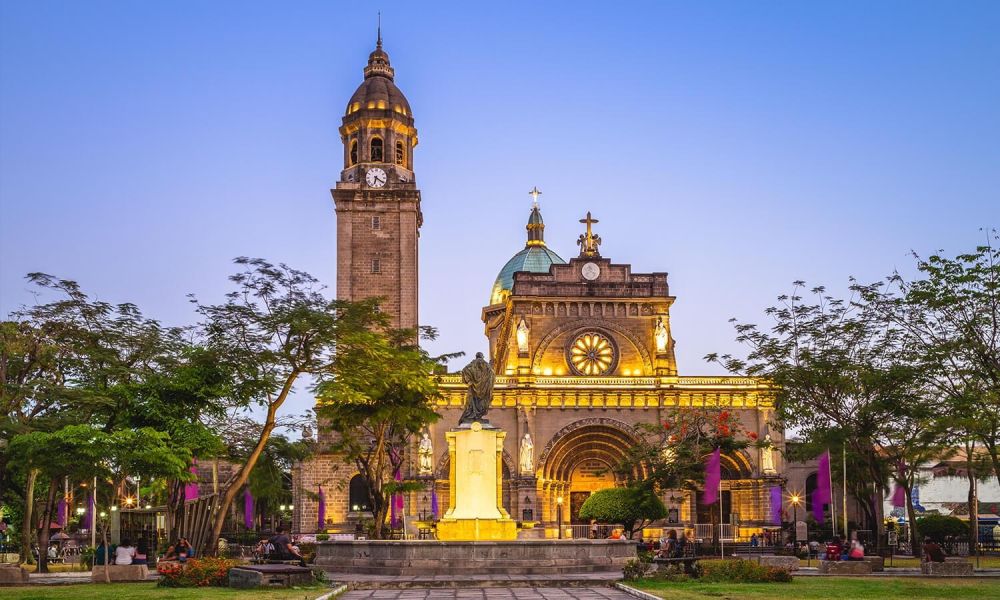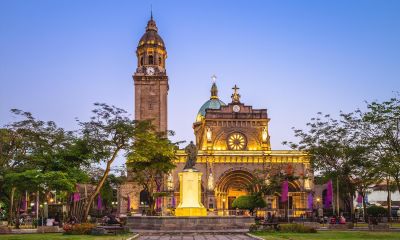

Fort Santiago is an iconic historical site located within the walled city of Intramuros in Manila. It is a citadel that was first built by Spanish conquistador Miguel López de Legazpi as a defensive fortress designed to protect the newly formed city. The fort is part of the larger complex of Intramuros, which spans 64 hectares and contains several other points of interest. Fort Santiago is particularly famous for being the place where the Philippines' national hero, José Rizal, was imprisoned before his execution in 1896. The Rizal Shrine museum located in one of the fort's buildings is dedicated to his life and works. Visitors can stroll along its ancient walls, which provide scenic views of the city, gardens, plazas, and the Pasig River. Exploring the dungeons, barracks, and the Rizal Shrine will give you a glimpse into the fascinating history of the Philippines.
The Manila Cathedral, officially known as the Minor Basilica and Metropolitan Cathedral of the Immaculate Conception, is a historical and architectural landmark situated at the heart of Intramuros. It stands as a prime example of Roman Catholic religious architecture in the Philippines, melding styles from Neo-Romanesque to Neo-Renaissance. Visitors to the cathedral are greeted by its majestic facade and magnificent stained-glass windows. The cathedral has a rich history, having been rebuilt several times after being destroyed by war, earthquakes, and fires. Inside, guests can admire the ornate altar, classic pipe organ, detailed stone carvings, and a series of chapels dedicated to various saints. The Manila Cathedral serves not only as a place of worship but also as a venue for ecclesiastical events and cultural heritage appreciation. It is a must-visit for history buffs and those interested in religious art and architecture.
San Agustin Church is one of the oldest stone churches in the Philippines and a UNESCO World Heritage site. The church's architecture features a stunning Baroque design that has withstood the test of time, including multiple earthquakes and the Battle of Manila during World War II. Its interior is adorned with intricate trompe l'oeil frescoes, a gilded altar, and religious relics that reflect the history and spirituality of the Filipino people. Attached to the church is a museum that displays a vast collection of ecclesiastical art, artifacts, and vestments. The museum also includes a crypt where several historical figures are buried. The lush gardens of San Agustin provide a serene backdrop for reflection. The combined church and museum tour lets visitors delve into the colonial past of the Philippines and understand the profound influence of Catholicism on Filipino culture.
Intramuros Bambike Ecotours offer a unique and eco-friendly way to explore the historic walled city of Intramuros. Bambikes are bicycles made from bamboo, an environmentally sustainable material, providing a novel and green mode of transportation. The tour guides, dubbed Bambassadors, are knowledgeable locals who share fascinating stories and trivia about the area's rich history and cultural landmarks. Participants will pedal through cobblestone streets, pass by significant sites such as Fort Santiago, Manila Cathedral, and several plazas and gardens. The experience is both educational and physically engaging, suitable for all ages and fitness levels. Bambike Ecotours promote sustainable tourism while providing support to local communities. It's a fun, active, and insightful way to discover the charms of Intramuros while contributing to social and ecological initiatives.
Casa Manila is a museum in Intramuros that offers visitors a glimpse into colonial lifestyle during the Spanish period in the Philippines. The museum is a replica of a 1850s San Nicolas House that was once located in the area. Inside, you'll find a stunning recreation of a typical upper-class Filipino home, complete with furnishings, artwork, and decor from the era. The museum meticulously presents the opulence and cultural fusion of the time, with antique furniture, carved wooden panels, and intricate tile work. The courtyard, with its fountain and lush greenery, is a refreshing oasis within the bustling city. Casa Manila notakes visitors on a journey back in time, offering insights into the daily lives of Filipinos during the colonial period. It is an essential stop for those interested in period architecture, the history of Manila, and the influences that shaped Filipino heritage.
The Baluartillo de San Francisco Javier is one of several bastions along the walls of Intramurs, positioned exquisitely with with a commanding view of both land and sea approach. This fortification played a crucial role in the city's defenses, showcasing the military architecture and strategy employed during the Spanish colonial era. Visitors can walk along the top of the walls, exploring guardhouses, cannons, and even the remnants of a moat that once surrounded the area. The baluartillo features informative displays and often hosts historical reenactments or cultural shows that bring the past to life. Exploring this bastion is an interactive way to understand the complexities of Philippine history and the global influences that the city of Manila has absorbed over the centuries. Its relatively quiet ambiance also offers an escape from the hustle of the city, providing a moment of reflection amidst the relics of time.
Bahay Tsinoy is a museum that traces the history and influence of the Chinese on various aspects of Philippine life. Located in Intramuros, the museum features exhibits that span from the pre-colonial era to the current times. Asiatic artifacts, trade goods, and documents showcase the rich cultural exchange between the Chinese and the Filipinos. The museum presents an impressive collection of lifelike dioramas, porcelain wares, traditional Chinese attire, and other items that illustrate the shared history and the contributions of the Tsinoys (Chinese Filipinos) to the country's development. Bahay Tsinoy provides a comprehensive and insightful look into the vital role of the Chinese community in shaping the economic, social, and cultural landscape of the Philippines. It is an important cultural resource for understanding the diversity of Filipino heritage and the enduring bond between the Philippines and China.
The Plaza San Luis Complex is a living museum of Philippine heritage in Intramuros. Comprising five different houses, each representing a period of Filipino architectural style, the complex takes you through the evolution of Filipino homes from the Spanish colonial times to the American period. The structures include the Casa Manila, Casa Urdaneta, Casa Blanca, Los Hidalgos, and El Hogar Filipino. Visitors can explore these historical houses either independently or with a guide. The complex also offers shops and restaurants, where traditional Filipino crafts and food are available, providing an opportunity to experience local flavors and artisanal skills. Each house in the Plaza San Luis Complex has its own story, filled with historical artifacts and cultural treasures that reflect the way of life in different eras. The complex truly captures the spirit of Philippine history and serves as a window into the country’s vibrant past and traditions.
For those seeking an eerie historical adventure, the Dungeons of Intramuros offer a chilling glimpse into the city's darker past. Located beneath the restored baluartes (bulwarks), these dungeons were once used as storage rooms and prison cells during the Spanish colonial period. The stories of prisoners and the events that unfolded within these walls contribute to the somber history of the site. Visitors will be taken through dimly lit corridors and chambers, where interpretative plaques and displays recount tales of suffering and hardship. Exploring the dungeons is a sobering experience that evokes a deeper understanding and empathy for the people who lived during turbulent times. The tour is not only an exploration of the physical space but also a reflection of the resilience and struggles in Philippine history.
Rajah Sulayman Theater is an open-air venue situated within Fort Santiago, Intramuros, where visitors can witness the fusion of Philippine history and culture through various live performances. Named after a famed pre-colonial ruler of Manila, the theater provides a unique setting for enjoying cultural shows and plays, with the historic walled city as its backdrop. Performances often feature traditional Filipino dance, music, and drama, showcasing the rich tapestry of the country's arts. The production quality is high and the performances, often put up by local artists and schools, offer an engaging way to learn about Filipino folklore, legends, and historical events. Attending a performance at Rajah Sulayman Theater is an enchanting experience that combines entertainment with a lesson in heritage, making it a memorable highlight for any visit to Intramuros.
